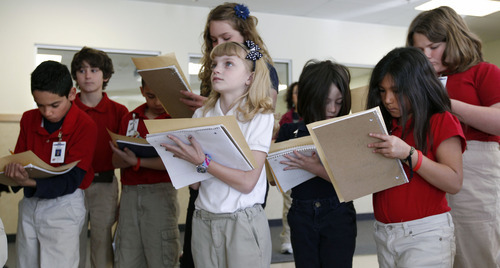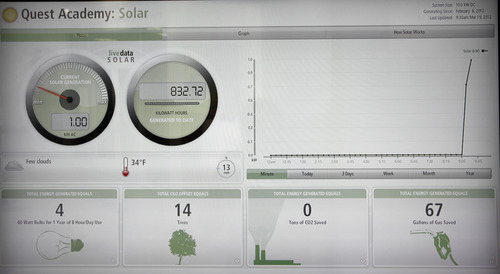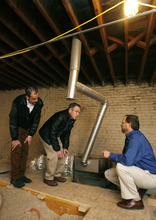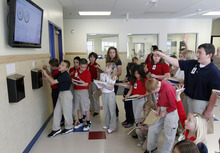This is an archived article that was published on sltrib.com in 2012, and information in the article may be outdated. It is provided only for personal research purposes and may not be reprinted.
Solar power is no longer just a textbook topic for five Utah charter schools.
A handful of schools, from North Star Academy in Bluffdale to Quest Academy in West Haven, recently installed solar arrays that power not only their schools, but also their curriculums with real-world examples of green energy.
There is no better example of that mix between education and application than at Quest Academy, where officials installed a 42-inch monitor to measure, in real time, the solar panels' impact on the school and the environment.
The monitor provides data on environmental factors such as CO2 emissions, as well as on the amount of money the school is saving by having its own power source.
"You can't see the solar panels," Principal Lani Rounds said, "but you can see the monitor and what the panels are doing. And it's mesmerizing."
With Quest Academy's emphasis on technology, Rounds said renewable energy goes hand-in-hand with the school's mission of creating a tech-rich environment.
But the solar initiative isn't unique to Quest Academy. The Rocky Mountain Blue Sky Program donated $1 million to fund 12 projects in Utah, including five charter schools and seven other facilities such as Weber State University, Utah's Hogle Zoo and an animal shelter in Moab.
The participating charter schools: Quest Academy in West Haven, Maria Montessori Academy in North Ogden, North Star Academy in Bluffdale, North Davis Preparatory Academy in Layton and Hawthorn Academy in West Jordan.
Charne Adams, principal of North Star Academy, said the panels have enhanced education at her school.
"The solar-energy project," she said, "makes the students' projects come alive."
In the short time since Quest Academy brought its panels online March 1, Rounds said environmental awareness has become part of the school's routine.
Alyssa Zimmerman, for instance, said her fifth-grade class has started turning off the lights and opening the blinds to save energy. She is doing the same at home.
Quest Academy has implemented a Watt Smart program, which solicits ideas from students each week on ways to conserve energy. If the school decides to put an idea into practice, the student wins a prize. Students also are encouraged to share energy-friendly techniques from home.
"One student said he went home and installed a solar panel on his train set," Rounds said. "He came the next day and said the solar panel wasn't working out as well as he hoped, so he created a wind turbine instead."
So how much energy does Quest Academy's solar array generate? About 16,800 kilowatt hours of electricity each year.
Bonnie Hagen, a grant writer who snagged solar-generation dollars for Quest Academy, said the panels produce enough energy each year to run a refrigerator for 1,000 days or keep a 75-watt light bulb shining for 25 years.
"This offsets the amount of coal-powered energy the school would have used," Hagen said. "It results in fewer emissions and waste, as well as alleviates the burden on the electrical grid."
Hagen seconded the opinion of the charter principals in saying that even more important than schools' saved money — which amounts to about $5,000 a year — are the learning experiences the solar panels provide for students and the community.
"We have an opportunity to influence our students, the future leaders and members of our society," she said. "We believe most people want to take steps to help the environment, but it's hard to know where to start."
Hagen said the solar array allows students not only to be informed about renewable energy, but also to be comfortable using it. The information from the monitors — combined with the practical application — teaches students and the community how to make a difference.











